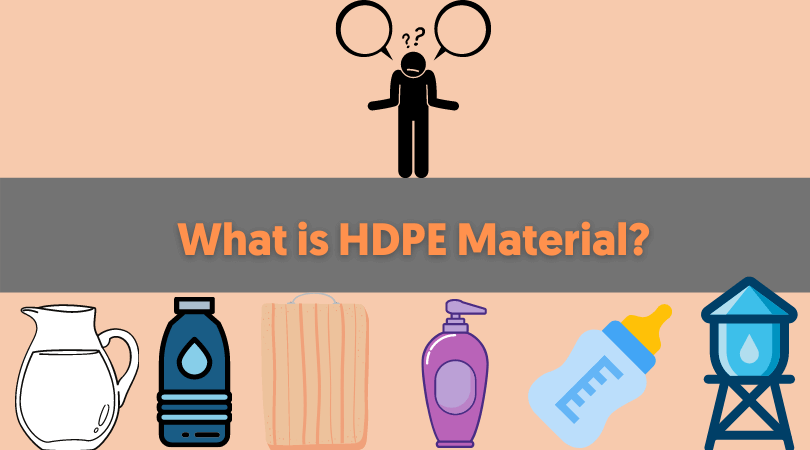What is HDPE Material?
High-Density Polyethylene, aka HDPE, is a trendy thermoplastic material made from petroleum. HDPE is known for its excellent tensile strength, high melting point, low cost, and good impact strength. Because of such impressive properties, HDPE can be used in various applications like milk jugs, plastic bottles, beach bottles, cutting boards, and piping.
The melting point of HDPE is 130°C, thus, making it easy to fabricate and weld using standard thermoplastic welding equipment, mainly available in sheet and rod forms.
Accessible welding properties and versatility make HDPE the right choice for manufacturing more oversized plastic products like water tanks and chemical tanks, which are difficult to manufacture without using high-grade plastic material.
HDPE density is also impressive, catering to plastic manufacturers looking to make automobiles and healthcare applications.

HDPE is also available in multiple additional grades. It can be utilized to manufacture various products from many categories like FDA-compliant cutting boards, disinfectants for medical facilities, woodgrain texture for the outdoor environment, etc.
HDPE Properties
Enhanced Stiffness HDPE
Conventionally, used for applications that are supposed to last for a long time (at least 8 to 10 years). It offers maximum flatness and consistency and is 25% thicker than the original HDPE material.
UV Stabilized grade HDPE
It does exactly what it sounds like. Typically, 25% to 30% lighter than the original HDPE is mainly utilized to resist UV and water exposure.
Those properties and availability in the sheet form make this HDPE a prime choice for manufacturing marine products, water tanks, playgrounds, outdoor cabinetry, etc.
Cutting Board grade HDPE
This HDPE Material is extensively used for manufacturing food-related products, primarily in food storage space.
It meets all the FDA requirements to directly or indirectly contact food and related items.
It is resistant to hot water, and cleaning chemicals come with no absorption ability for moisture. Those properties make it perfect for the F&B Sector.
Antimicrobial HDPE
Antimicrobial HDPE has a unique resistance property towards bacteria, algae, and fungi. What makes it resistant to them is its unique molecular configuration.
This HDPE is bonded at a molecular level, so it retains its usefulness for a prolonged period. It also works and blends well with woodworking tools, which makes it solid and durable.
The durability makes this HDPE an excellent choice to be implemented in hospitals, clinics, nursing homes, medical carts, etc.
The unique property of resistance to bacteria and algae is helping this HDPE material steadily increase its presence in the retail industry, where showcasing and storing products for a long time is a crucial part of their business.
Engravable HDPE
The UV-stabilized HDPE is durable, weather-resistant, and available in sheet form, effortlessly blending with machines. This HDPE material comes in multiple color options.
The colors are reliable, long-lasting, and don’t need additional painting or refinishing.
That color-holding nature makes it applicable to produce carnival equipment, number plates, toys, and children’s furniture.
WoodGrain HDPE
WoodGrain HDPE is known for being easily operable with essential woodworking equipment and for negligible maintenance.
It comes with an authentic woodgrain color and is flexible enough to be shaped for desired objects.
Colors can be changed on every sheet. No worries about rotting, chipping, and eliminating. Suitable for outdoor applications construction and related products, furniture, and playgrounds.
Interesting Content – What is PEEK Material?
Below are the general properties of HDPE Material
| Property | Unit | Value |
| Physical | ||
| Melting Point | °C | 126 – 135 |
Coefficient of Thermal Expansion x 10-5 | cm / (cm °C) | 12.5 – 18.0 |
| Density | g mL-1 | 0.955 – 0.961 |
Heat Deflection Temperature, 0.5 MPa | °C | 64 – 77 |
Heat Deflection Temperature, 1.8 MPa (unannealed) | °C | 76.5 – 78 |
Shore Hardness, D Scale | – | 55 – 67 |
| Mechanical | ||
Tensile Strength, Yield at 23 C | MPa | 23.0 – 29.5 |
Tensile Strength, Break at 23 C | MPa | 30.5 – 33 |
Tensile Modulus at 23 C | MPa | 900 – 1550 |
| Flexural Modulus | MPa | 970- 1380 |
Flexural Strength, Yield | MPa | – |
| Izod Notched | J/m (kJ/m2) | 71 – 159 (20) |
| Electrical Properties | ||
| V/mm x 104 | 2.1 – 3.5 | |
Dielectric Constant @ 1 MHz | – | 2.2 – 2.4 |
Volume Resistivity | Ohm-cm | 6 x 1015 |
Dissipation Factor @ 1 MHz | – | 0.0001 – 0.0005 |
| Other Properties | ||
Continuous Service Temperature | °C | -73 – 82 |
Water Absorption, 24 hr. Immersion | % | 0.01 – 0.03 |
Linear Mold Shrinkage | cm/cm | MPa |
Advantages of HDPE Material

HDPE has several benefits for the manufacturer and buyer. Let’s discuss some of them.
HDPE is corrosion-resistant, making it suitable to produce essential public infrastructure like underground piping as it wouldn’t rust from weather effects and is long-lasting. Sterilization of HDPE makes it perfect for food and beverage storage containers.
Easy malleability and moldability are other standout features of HDPE material as it increases its applications substantially.
The material is rigid and has an impressive melting point of 210 to 270°C.
However, once it melts, it can produce many products like water tanks, cutting boards, detergent bottles, shampoo bottles, pipings, etc.
HDPE material has a fabulous strength-to-density ratio of 0.93 to 0.97 g (it might not seem a lot compared to LDPE, but there’s a catch). When seen under a microscope, HDPE molecular structure differs from LDPE.
It has a linear system with little branching, which results in a more robust molecular structure and greater tensile strength.
That’s why a 60-gram HDPE cup can hold about a gallon of liquid without bending.
HDPE is an easily recyclable material. Recyclability is an essential factor, especially these days when the global carbon footprint is on the rise.
Recycling HDPE can save up to 50% of your material cost, and no worries about quality, as recycled HDPE material is said to be as good as “virgin” material.
Disadvantages of HDPE Material

Although there are a few HDPE disadvantages, I still want to shed some light on them.
- High flammability
- Considerably, high thermal expansion.
- Non-resistant to chlorinated hydrocarbons
- Non-resistant to oxidizing acids
Applications
Fantastic mechanical properties make HDPE suitable for many high-end applications across various industries.
- Consumer Goods
- Packaging Applications
- Fibers and Textiles
Consumer Goods

HDPE’s inexpensiveness and easy processability with injection and extrusion molding make it a highly usable consumer goods application.
Products like kitchen wares, ice trays, food and packaging, dustbins, etc.
Also Read – Which is the Best Acrylic Glue? | The Best Plexiglass Glue
Packaging Applications

Impact strength and reasonable chemical resistance help HDPE polyethylene with applications in industrial bulk containers, jerry cans, drums, fruit juices, crates, bottles for keeping liquid foods, etc.
Fibers and Textiles

High tensile strength and easy processability boost HDPE’s competitiveness in manufacturing products like industrial and decorative fabrics, fishing and sports nets, ropes, and nets.
Other applications include fuel tanks – for the automobile industry, wires, and cables, pipes for drainage, industrial uses, cable protection, large inspection chambers, gas, water, sea downspouts, etc.
Is HDPE Toxic
Chemically, HDPE is considered relatively inert, meaning it doesn’t readily react with other substances. This inertness contributes to its use in food-grade applications, which has received approval from agencies like the U.S. Food and Drug Administration (FDA) and the European Food Safety Authority (EFSA).
Generally, HDPE doesn’t leach chemicals into food or beverages, making it widely used for milk jugs, juice bottles, and similar containers.
However, this does not make HDPE universally safe. Under specific conditions, HDPE may degrade. Exposure to UV radiation can weaken the material and, over time, potentially release harmful substances.
Moreover, recycling HDPE can introduce contaminants if not done carefully. Another concern comes from the manufacturing process of HDPE, which often involves chemicals like phthalates associated with endocrine disruption.
Although these chemicals are generally removed during production, trace amounts may still exist.
So, is HDPE toxic? The consensus based on current evidence suggests that HDPE is essentially non-toxic when used appropriately.
However, if you’re considering long-term, high-temperature, or critical applications (e.g., medical devices), it would be prudent to scrutinize the manufacturing and recycling processes to minimize risks.
Additionally, emerging technologies like nano-additives in plastics may change the toxicity profile, something to keep an eye on for future assessments.
The Future of HDPE Material
[visualizer id=”935″]
The future of high-density Polyethylene seems bright as a study conducted by Market Research Future states that it can show a CAGR growth of 4.21% until 2023(Despite the Covid-19 pandemic virtually stopping the global manufacturing industry).
The injection molding method is the most significant contributor to HDPE products, with almost a quarter of the market share.
HDPE is also extensively utilized by manufacturing firms for safeguarding goods in storage.
Given the ever-rising demand for packaging films, the thin-film applications of HDPE are expected to witness exponential growth.
Two things will work in the HDPE’s favor – the first is it is utilized in making flexible and rigid packaging.
Second, increasing awareness against single-use plastics is expected to build up a healthy business ecosystem for HDPE and, in turn, benefit the manufacturers.
Expanding the packaging and automobile industry will keep the demand for HDPE steady worldwide (Especially in North America and Europe).
Talking about the Asian market, China, India, Thailand, Indonesia, and Bangladesh will keep the momentum going with flourishing construction and automobile industries.
Another major industry giving a significant push to HDPE is E-commerce. People are more comfortable shopping online than ever before, which will drive the demand in developed and developing nations.
HDPE material is strong, rigid, and highly applicable; it can improve productivity and reduce costs.
FAQs
Why is HDPE used in hospitals?
There are several factors behind HDPE’s rapid adoption in hospitals and the medical industry in general. Its features, like high impact resistance, low moisture absorption, corrosion resistance, and resistance from chemicals, and most importantly, processing versatility, make it a go-to plastic material for the medical industry.
It does not splinter or rot, does not fade and retain bacteria, and is reasonably affordable, attracting hospitals to create reliable and cost-effective medical devices.
Can you microwave HDPE?
HDPE is safe and FDA-approved for food applications making it compatible with microwaves, and It has a tolerance of -40 to 266 degrees Fahrenheit before distortion. In the food packaging industry, HDPE is generally used for containers.
Can HDPE be boiled?
HDPE comes with an outstanding temperature range, and short periods of heating with up to 248°F (120°C) or for long periods up to 230°F (110°C) are considered safe. That makes the thermoplastic used in several food grade applications.
Which is stronger, HDPE or PVC?
The comparison is a bit unusual, and both materials are solid and rigid in their own right. Still, if we consider specific metrics, PVC is more robust and heavier in terms of brute strength, but HDPE is more rigorous and more heat and abrasion-resistant.
Is HDPE stronger than wood?
HDPE has been exhibited to be more stable than most plastics, wood, and even metals. It possesses excellent impact strength and can easily withstand your facility’s pressure and harsh scenarios. It won’t even scratch or dent, so you don’t need to keep replacements hands-on.
Suggested Read –
- Antistatic vs. Static Dissipative Plastics | Which One to Choose?
- PTFE Vs. Teflon: What are The Differences?
- 7 Best UV Resistant Plastics For Outdoor Applications
- 6 Best Plastic Molding Techniques | A Complete Analysis
- What is TPV Material? | A Simple and Detailed Guide
- What is ABS Plastic
- What is Bakelite?: The Plastic That Changed the World
The Takeaway
In summary, HDPE is a versatile polymer that is used extensively in various industries such as construction, packaging, and healthcare. Its exceptional strength, chemical resistance, and durability suit these applications. Moreover, HDPE’s lightweight nature, ease of fabrication, and recyclability render it an environmentally sustainable option for many uses.
With technological advancements, it is anticipated that HDPE demand will increase further with the discovery of new applications. HDPE is a crucial asset to modern society and a significant contributor to sustainability.
I would appreciate it if your share your reviews in the comment box.
Peace Out!!
Quick Navigation

Interesting for wooden fence replacement.
[email protected]
It surely is.
The approach you have described about HDPE is very good I really liked this article Thank you very much
I appreciate your feedback 🙂
Long term degradation and chronic nanoplastic particle fallout is a major health danger to the planet and human health eg lung conditions and cellular invasion into other bodily organs and parts.
You disregard this. UV stabilisers don’t stop it – the process remains steady – maybe slower in terms or plastic structure weight loss but more pernicious because the wear and tear is of finer and finer particles which have exponentially greater surface area and potential attachment of toxins, and easier transmission into every part of the body and egregious inflammation, cancer, heart, etc. potential.
It is a major health risk – far worse than asbestos because of the ubiquity of this material.